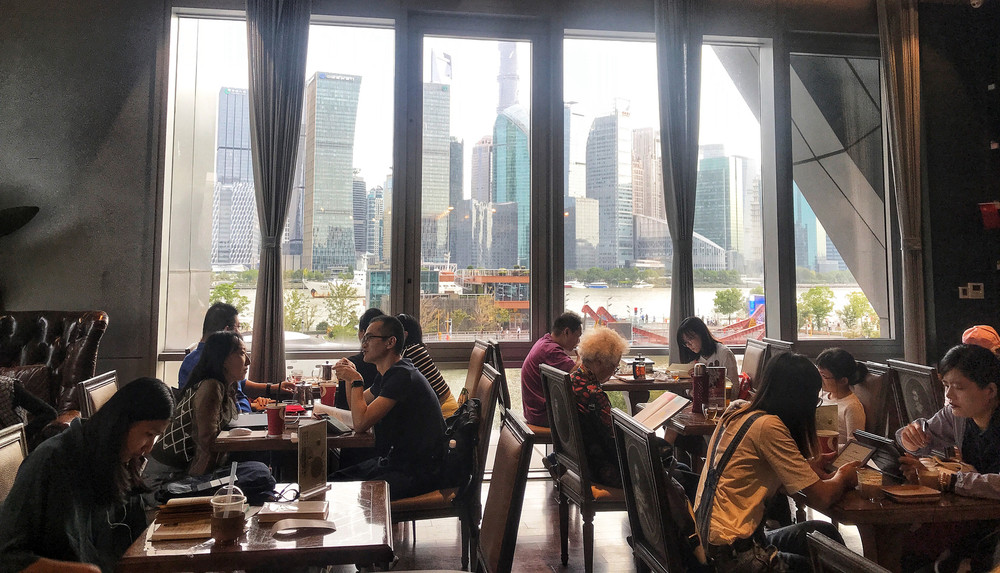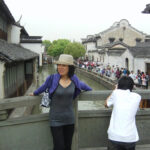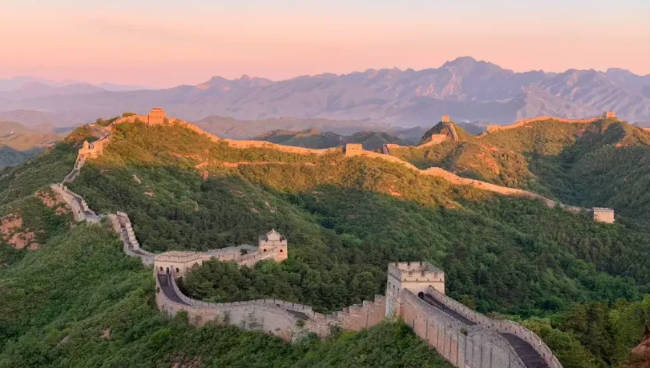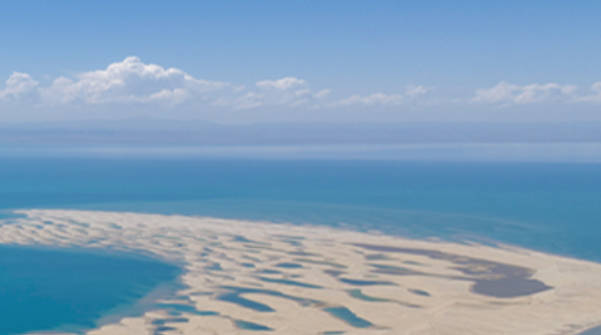Shanghai, the enchanting metropolis, is a place you’d wish to revisit no matter how many times you’ve been. It’s a connection, a longing, that fills you with memories as you stroll through its streets—reminiscent of the Oriental Pearl Tower, the Bund, the Exotic Building Cluster, the soft dialects, cheongsams, dazzling lights, and bustling traffic… It’s this magic that draws us to set off again during this year’s National Day holiday. On this Shanghai adventure, by choosing four distinctive ‘niche’ routes, we successfully evaded the crowds and slowly uncovered the enchantment of this magical city.

Outline:
1. North Bund
2. New Landmarks in Pudong
3. Three ‘Street Sweeping Routes’
4. Shanghai’s Creative Parks
Recommended North Bund Route:
Moses Synagogue Site — Jian Tou Bookstore — Yacht Club — North Bund Riverside Green Space — Music Gate — Magic City Matrix — North Outer Ferry Bridge — Zhapu Road Bridge
If you wish to enjoy the beauty of the Huangpu River without being overwhelmed by crowds, try this niche route where surprises await at every turn.
No matter the season, the Bund in Shanghai is always crowded and lively, perhaps the most quintessential Shanghai-style photo spot in the city. However, not far away in North Bund, you can still appreciate the riverside views with fewer people. Take the subway line 12 to the International Cruise Terminal Station, and upon exiting, you’ll find the White Magnolia Shopping Center, filled with a variety of delicious foods.
Exiting the building, not far across is North Bund. Moses Synagogue was closed early, so we moved directly to the Jian Tou Bookstore located in the Fair Road Jiayu Building.
Exiting the bookstore and walking to the riverbank leads you to the Yacht Club. The yachts here depart in a unique manner, entering a sealed lock chamber, waiting for the water level inside to equalize with that of the Huangpu River before departure, reminiscent of the locks in the Panama Canal.
North Bund Riverside Green Space, spanning 2.5 kilometers, features a rubber track, making it an excellent place for a leisurely stroll or a run.
The Music Gate, located at the Guotou Building, with its three spheres, is a landmark of North Bund.
The Magic City Matrix is an outdoor climbing activity venue, facing an area by the river that is currently undergoing renovation and upgrade. The outside of the glass fence thoughtfully displays the scene before the renovation.
Lin Huiyin and Xu Zhimo welcomed Tagore at Huishan Dock, marking the beginning of his first journey to China by boat.
On the way to the White Outer Ferry Bridge, you can always see the ‘three pieces’ of the magic city and the Oriental Pearl Tower across the Huangpu River, looking more three-dimensional and charming in the afterglow of the sunset. The reflected light on the outer walls and the shimmering waves on the river surface complement each other, creating a tranquil yet bustling scene.
During the National Day period, celebrating the 70th anniversary of the founding of New China, a Shanghai Pujiang Music and Light Show was held on the Bund and Lujiazui by the Huangpu River, from 19:00 to 22:00, with official performances at every hour and half-hour, lasting about 5 minutes each. The repertoire included: ‘The East is Red’, ‘Bund Promenade’, ‘Me and My Motherland’, ‘Ode to the Red Flag’.
Standing on the Zhapu Bridge, in front of you is the brightly red Outer White Ferry Bridge, behind you is the brightly lit orange Sichuan North Road Bridge, and underfoot, the Zhapu Bridge spans the Suzhou River like a white ribbon. From here, you can gaze across the Huangpu River to the night view of the magic city’s ‘three pieces’ and the Oriental Pearl Tower. The Shanghai Post Museum on the side of the Sichuan North Road Bridge appears particularly aloof in the night.
If the night view from the White Outer Ferry Bridge and Zhapu Road Bridge is too crowded, you can also go to Shanxi Road Bridge and Zhejiang Road Bridge, which are not only low-key and less crowded but also filled with the atmosphere of the marketplace.
Recommended Pudong New Scenery Route: Pudong 1862 Fashion Art Center – Lujiazui Shanghai Tower – Duoyun Bookstore – Guanfu Museum – Take the Lujiazui Ferry to the Bund – Nan Waitan Old Wharf. This ultra-niche Pudong one-day tour starts with a subway ride to Pudong Avenue Station on Line 4, followed by a 1-kilometer walk to the 1862 Shipyard Fashion Art Center (converted from the 150-year-old shipyard), located directly opposite the North Bund. The historic Shanghai shipyardA taxi ride to Shanghai Tower on Yincheng Middle Road leads you to the recently popular Duoyun Bookstore, located on the 52nd floor of Shanghai’s tallest building. This bookstore, hidden among the clouds, boasts large floor-to-ceiling windows offering an excellent view of the Huangpu River. The interior is bright, with all bookshelves designed in a simple arc shape, allowing views of the large glass windows and the cloudy sky beyond. On a clear day, with a blue sky and white clouds, sitting by the window reading a book and looking up to see the enchanting Shanghai Bund river view is a magical experience. Adjacent to the bookstore is a beverage bar offering juices and coffee, next to the entrance of the Cape of Good Hope, a window-side viewing area that provides views of the Huangpu River and the Pudong scenery. Entry requires the purchase of a juice or coffee for around 50 yuan. The bookstore, a new internet sensation, is very popular and often requires queuing, with a dedicated elevator on the 1st floor of the building.
In the same building, on the 37th floor, lies the Guanfu Museum, the first private museum in New China, founded by Ma Weidu as the first director. The museum features four permanent exhibition halls: Porcelain Hall, East-West Hall, Metalware Hall, and Sculpture Hall, along with a temporary exhibition hall. The view of Pudong from the museum windows truly reflects the new height of Shanghai.
Walking from Shanghai Tower to the riverbank, you can take the ferry from the Dongchang Road Ferry Terminal in Lujiazui to the Bund’s Jinling East Road Ferry Terminal on the other side. The ticket is 2 yuan for a 10-minute ride, with scenery rivaling the Star Ferry from Tsim Sha Tsui to Central in Hong Kong. Wedding scenes are a common sight on the ferry. For a night cruise, buy tickets for the sightseeing ferry at the nearby Shiliupu Dock, with prices ranging from 80 to 150 yuan, depending on whether it includes meals and viewing area seats. Sightseeing car stops along the Bund offer a second-floor terrace, allowing on and off within 24 hours for 100 yuan.
The Bund is bustling with tourists both day and night, so it is recommended to visit the North Bund or the South Bund. The Old Wharf, a renovated area on the South Bund, is reminiscent of Si Nan Mansion and Xintiandi, with photogenic streets and an illusion of capturing all the details about Shanghai in an instant.
Shanghai, the Magic Capital, reveals a more elegant side when you turn a corner onto old streets lined with fallen plane trees, where historic old houses, unforgettable old flavors cherished by the locals, and a unique sentiment that truly belongs to Shanghai can be found.
Route One: Searching for the Old Shanghai on Yuanmingyuan Road. The area near the Bund is full of scenery. Avoid the Nanjing East Road section in the early morning and after 10 p.m., and you’ll find quiet corners filled with charm. The dim lights, combined with the zebra crossings on the streets, make every scene tranquil and gentle. The building at the intersection of Dianchi Road and Yuanmingyuan Road is a popular spot for wedding photos. Yuanmingyuan Road, quiet despite being close to the Bund, starts from Beijing East Road in the south and extends to Suzhou Road in the north, with many old buildings. From the east side, in order, are the former New Tian’an Church, the British Consulate, and the Peninsula Hotel. The eight connected old foreign-style houses on the west side are even more beautiful, including the True Light Building, the Lanxin Building, the Xiejin Building, the Hami Building, the National Association of the Young Women’s Christian Association of China, the Yuanmingyuan Apartment, the Ampere Foreign Trade Firm, and the Hui Mansion. Then visit the Bund Art Museum (the former site of the Shanghai Museum), the White Waibudiao Bridge, and the former New Tian’an Church, which skillfully blends Roman style with Gothic elements, featuring a bell tower in the middle and a chapel on each side, making it the only remaining waterfront church in Shanghai. The True Light Building, the Ampere Foreign Trade Firm, the Yuanmingyuan Apartment, and the Bund Art Museum offer rooftop views of the Oriental Pearl Tower.
Route Two: Exploring the Republican Stories of Old Shanghai on Wu Kang Road. Wu Kang Road, originally named ‘Fukangsen Road,’ is known as the ‘Celebrity Road’ of Shanghai, encapsulating nearly a century of history. The dense plane trees shade European-style buildings, the most famous of which is the Wu Kang Building. The building’s red brick walls, corner balconies, and triangular classical pediment windows exude the charm of the French Renaissance period.Even if it were moved to Paris, it would undoubtedly be a rare architectural masterpiece. The Normandy Apartment, with its shape resembling a huge ship waiting to set sail, is a testament to its name. Many visitors come to catch a glimpse of old Shanghai style, but it’s always a fleeting look. The film ‘Lust, Caution’ has made Wu Kang Road popular, attracting photographers in droves. The French Concession is filled with streets that hold hidden stories: the tile houses on Tianping Road, the lonely street corners on Yongfu Road, and the music box shop on Wu Yuan Road, all culminating in a taste of osmanthus wine. Wu Kang Road, less than two kilometers long, hides half of the city’s internet-famous landmarks and the century-old stories of old Shanghai. European style and modern trendy design span time, jointly interpreting the unique beauty of the city. Encountering a film crew shooting amidst the deep plane trees, one wonders if the script is about the most Shanghai in the deep plane trees. Drops Café, a quiet place, serves cold brew coffee that could be mistaken for a bottle of foreign liquor.
The visitor center on Wu Kang Road is particularly well done, featuring an exhibition of old photos of Wu Kang Road and distributing some Shanghai tourism materials. If you want to understand the old stories of the Republic of China in Shanghai, experience cultural heritage, or feel the touch of history while sightseeing and appreciating the scenery, then this place is a must-visit. Many small roads branching off Wu Kang Road hide its charm, and you have to approach it to hear its story. Old restaurants, cafes, bookstores, designer shops, and the French plane trees along the road – this is Shanghai. The same scenic spot can evoke different feelings in different people, and every time you come to Shanghai, you must come and see this place.
Elegant and distinctive old buildings, integrated with the plane trees on both sides, exude a tranquil and refined aura. Wandering through the former residences of historical celebrities on Sinan Road, not far from Wu Kang Road, one can marvel at the fleeting moments of time. Sinan Mansion, the only project in Shanghai dedicated to the preservation of a cluster of garden villas, boasts over 50 historically significant garden villas and various architectural styles, making it a focal point for Shanghai’s modern residential architecture. Strolling on Sinan Road, one can savor the interplay of architecture and plane trees. Nearby, the former site of the Shanghai Office of the Chinese Communist Party Delegation, built in the 1920s, is a three-story European-style garden residence and the only well-preserved and open-to-the-public Zhou Enlai memorial site in Shanghai. After the Anti-Japanese War, the delegation set up offices here, making significant contributions to the advancement of the Chinese people’s liberation cause, writing a glorious chapter in the history of the Chinese revolution. From here and the site of the First National Congress of the Chinese Communist Party in Xintiandi, it is evident that our party had a long-term vision, settling in the core of Shanghai early on.
The Shanghai Art and Design Museum, commonly known as the ‘Little White House’, is a discreet location with a ‘high-end’ charm, boasting a spiral staircase that rivals those in the Vatican Museums. The Moller Villa at the intersection of Yan’an Overpass and Shaanxi South Road is referred to as a castle from a dream, with Nordic architectural style, a castle amidst the bustling city. The Rong Mansion is a famous garden villa in Shanghai; in 2011, PRADA collaborated with a group of highly skilled craftsmen to renovate it, imagining how a luxury brand could combine with industrial architecture.
Shanghai Xintiandi, despite various criticisms, remains the most popular destination. Originally an old shikumen residential area, it was later transformed by developers into a modern leisure area for dining, shopping, business, and entertainment, still retaining the old bricks and tiles, revealing the local flavor and cultural heritage of old Shanghai. Foshan’s Lingnan Xintiandi, developed by the same developer, feels more down-to-earth than Shanghai’s, with the commonality being the presence of many good-looking men and women. Xintiandi continues to expand, and it is the best open-air bar area to date. An increasing number of design shops, clothing stores, and luxury stores are opening in Xintiandi, making it more like an alternative shopping mall, of course, under the guise of shikumen.
Shanghai has always been about integration, inheritance, and development. Route Three: Duolun Road Recreates the Charm of 1920s and 1930s Shanghai. Duolun Road, no more than 500 meters long, has been refurbished to recreate the charm of Shanghai in the 1920s and 1930s.After a century of vicissitudes, Duolun Road not only features numerous architectural styles within a hundred meters but also embodies the most outstanding wisdom. It is not content with merely preserving the past but keeps pace with the times, infusing contemporary connotations, and continuing to write a brilliant cultural history. It has become a model of concentrated red tourism resources and a deep integration of culture and tourism.
Someone once wrote online that this famous road is ‘full of hidden dragons and tigers’ and ‘compact yet powerful’. As the birthplace of the left-wing forces in the last century, it never loses the brilliance of advanced thought and is also the birthplace of multicultural breeding.
In just 500 meters, from the café inscribed by Wang Daoqian as ‘the cradle of left-wing writers’ to the Baroque-style ‘Hengfeng Tea House’, the Sino-European Christian church ‘Hongde Hall’, and the ‘Shanghai Duolun Modern Art Museum’ that gathers modern artistic atmosphere, there is much to explore.
In addition to the aforementioned places, there are the English Georgian-style ‘Xue Mansion’, residences from the Japanese foreign style period, neoclassical-style ‘White Building 1920’, Shanghai retro-style ‘Old Movie Café’, the dormitory site of China Art University in the late Victorian Anne Queen Revival style, the French neoclassical-style Bai Chongxi’s former residence, the Romanesque-style Liang Hongzhi’s former residence, and the Spanish Ottoman Turkish-style Kong Xiangxi’s former residence.
This Duolun Road, without some historical, political, and architectural knowledge, can be逛完 in just 15 minutes, but for the ‘four-have’ youth with ideals, morals, culture, and discipline, it is certain to take 1 or 2 hours to fully appreciate.
Diverse and abundant architecture; densely packed historical residences; antiques with storied pasts; and photogenic spots bustling with visitors. Across from Duolun Road lies Lu Xun Park.
Not far from Duolun Road, Tian’ai Road has inexplicably become a popular love lane, reminiscent of Paris’s Le Mur des Je T’aime.
Before coming to Shanghai, I chatted with a friend about the city. She expressed her fondness for the bourgeois charm of Sinan Road and Tianzifang, the luxury of Huaihai Road, and the brand concentration on Nanjing Road. Yet, these sensations are merely cold signs amidst the bustling commercial districts, filled with an unfamiliar and inauthentic atmosphere.
Each time I pass by Tianzifang in the Shanghai alleys, I see freshly painted exteriors (with different patterns each time), neatly restored shikumen, sparse foreign visitors, and hurried tourists checking in, all contributing to a sense of estrangement.
The Sun Moon Lake and Xintiandi are merely Shanghai’s ‘façade,’ hosting waves of guests. The shikumen in my earliest memories were from old movies and TV series, with narrow lanes built from bluestone, bearing the marks of their times, and adorned with spittoons, stools, and palm leaf fans. There were the noisy sounds of mahjong, quarrels, and the ever-indistinct Subei dialect.
The intersection of old and new architecture represents a city’s past and present, with people traversing through, being both the scenery and the hosts. The contrast between old alleys and new landmarks prompts the question of what has been lost with social progress—a way of life or a city’s charm?
Enviable are the friends in Shanghai who can spend their leisurely weekends exploring old Shanghai in bygone times, strolling through old streets, encountering storied buildings, sipping afternoon tea, and tasting the flavors of olden days.
Shanghai’s creative parks: 1. 1933 Old Factory Hall, accessible by metro lines 4 or 10 at Helen Road Station, was originally the Shanghai Municipal Council’s slaughterhouse, funded by the Public Concession’s Municipal Council, designed by British architects, and constructed by well-known domestic builders of the time. It was once the most modern, largest, and technologically advanced slaughterhouse in the Far East, known as the ‘concrete industrial machine.’ Only three such scale works exist worldwide, with the other two in the UK and USA no longer standing. Now it is the ‘1933 Old Factory Hall’ creative park.
This unique old building, with its square exterior and round interior, embodies the traditional Chinese Feng Shui concept of ’round sky and square earth.’ Features like ‘beamless slabs,’ ‘umbrella-shaped flower columns,’ ‘arc-shaped stairs,’ ‘corridor bridges,’ and ‘cattle paths’ blend together, creating an endless play of light and space, presenting a maze-like effect. It has now become a fashion creative design center and a national industrial tourism demonstration point, instantly turning into a gathering place for literary youth in the Magic City after being featuredColumbia Park, a newly reopened park by Vanke, is a new landmark in the Magic City. Accessible by metro lines 3 or 4 at Yan’an West Road Station, it boasts a rich Moroccan style and a strong sense of vacation, making it another photography hotspot. Although newly opened and relatively crowded, it is not congested.
M50 Creative Park at 50 Moganshan Road may appear ordinary from the outside but reveals a vast world once entered. This light industrial park is home to numerous artists’ studios, large galleries, and art spaces, and is also a creative hotspot for young literati to check in. Here, you can take a photo with a flamboyant graffiti wall as your backdrop, browse through the books in an old factory bookstore, and enjoy a cup of coffee filled with artistic flair.
Thames Town, located in Songjiang District, is accessible by exiting at Songjiang Xincheng Station on Metro Line 9. Originally a large real estate development, the town has been well planned and designed to resemble an ‘authentic’ European town, with a pleasant overall atmosphere. Characterized by European architecture, it features a Catholic church, a red train, and the famous Zhongshuge bookstore. After years of development, it has truly become imbued with a natural, non-pretentious European daily life atmosphere, and has also become a base for wedding photography.
I appreciate the convenience of Shanghai and marvel at its ever-changing landscape. Despite the hurried pace, the state of mind remains natural. I am happy to share this memory with you. For any details not covered in this travel guide, please feel free to leave a message. I am very willing to share my experiences and be your walking guide.









